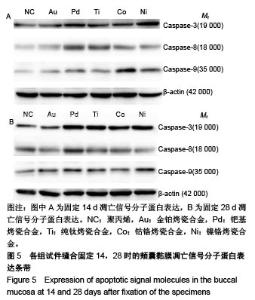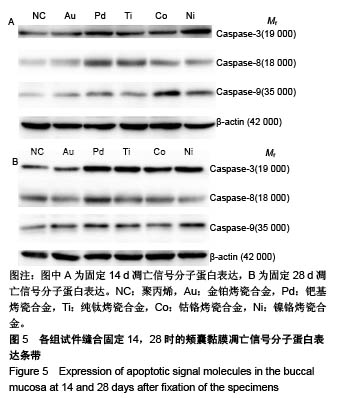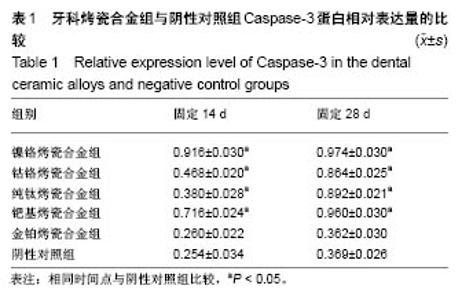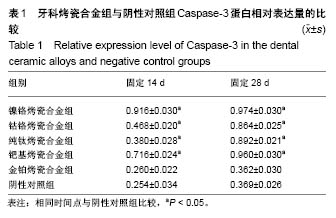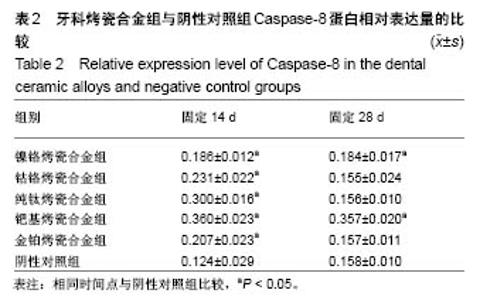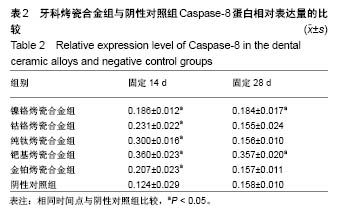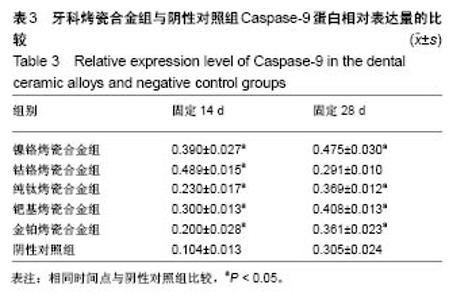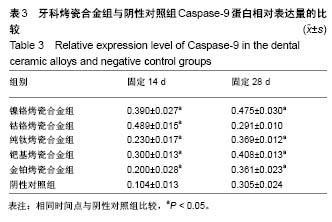| [1] 张长源,程辉,王希,等.反复熔铸Ni-Cr烤瓷合金体外细胞毒性实验(MTT法)[J].实用口腔医学杂志,2010,26(3):306-309.[2] 林泓磊,江磊,张长源,等.反复熔铸对钴铬烤瓷合金细胞相容性的影响[J].上海口腔医学,2017,26(3):246-250[3] Faccioni F, Franceschetti P, Cerpelloni M, et al. In vivo study on metal release from fixed orthodontic appliances and DNA damage in oral mucosa cells. Am J Orthod Dentofacial Orthop. 2003;124(6):687-694. [4] Cortizo MC, DeMele MF, et al. Metallic dental material biocompatibility in osteoblast like cells: correlation with metal in release. Bio Trace Elem Res. 2004;100(2)151-168. [5] Schedle A, Samorapoompichit P, Rausch-Fan XH, et al. Response of L-929 fibroblasts, human gingival fibroblasts, and human tissue mast cells to various metal cations. J Dent Res. 1995;74(8):1513-1520. [6] Y-T 0127.13-2009,中华人民共和国医药行业标准,口腔医疗器械生物学评价:试验方法:口腔黏膜刺激试验[S].北京:中国标准出版社,2009.[7] ISO 10993-12-2007. Biological evaluation of medical devices—Part 12: Sample preparation and reference materials, 2007. [8] Wolf BB, Green DR. Suicidal tendencies: apoptotic cell death by caspase family proteinases. J Biol Chem. 1999;274(29):20049-20052. [9] Joseph EK, Levine JD. Caspasesignalling in neuropathic and inflammatory pain in the rat. Eur J Neurosci. 2004;20(11):2896-2902. [10] 孟贺,李秀梅,徐艳丽,等.3种牙科金属材料对L929细胞的毒性及对凋亡相关基因与蛋白表达的影响[J].上海口腔医学, 2013,22(1):30-34.[11] 孟贺,丁洁,李任,等.4种牙科金属材料对成纤维细胞L929凋亡相关基因及蛋白表达的影响[J].华西口腔医学杂志, 2013,31(3):242-246.[12] 谢颖.线粒体损伤拮抗剂在Cr(VI)所致肝细胞凋亡中的保护作用[D].长沙:中南大学,2014.[13] 李秀梅战,德松.Caspase-3表达强度评价齿科合金生物相容性的实验研究[J].中国医学工程,2011,19(7):70-73.[14] 郭毅.纳米级氧化锆与钛合金颗粒诱导大鼠海马凋亡的对比性研究[D].徐州:徐州医学院,2013.[15] 万书健,苏俭生.3种铸造金属全冠戴用后对外周静脉血淋巴细胞凋亡的影响[J].口腔医学,2009,29(2):73-76.[16] 焦俊霞,高维娟.细胞凋亡的信号转导机制研究进展[J].中国老年学, 2010, 30(6):853-856.[17] Nutt LK, Pataer A, Pahler J, et al. Bax and Bak promote apoptosis by modulating endoplasmic reticular and mitochondrial Ca2+ stores. J Biol Chem. 2002;277(11):9219-9225. [18] Brenner C, Kroemer G. Apoptosis. Mitochondria--the death signal integrators. Science. 2000;289(5482):1150-1151. [19] Huang DC, Strasser A. BH3-Only proteins-essential initiators of apoptotic cell death. Cell. 2000;103(6):839-842. [20] 吴科达,王远亮,潘君.生物材料诱导细胞凋亡的研究进展[J].生物医学工程学杂志,2005,22(2):413-419.[21] 陈书宝,张睿,李锐.不同齿科合金对成纤维细胞增殖凋亡的影响及机制研究[J].医学研究杂志,2018,47(1):103-107. |
